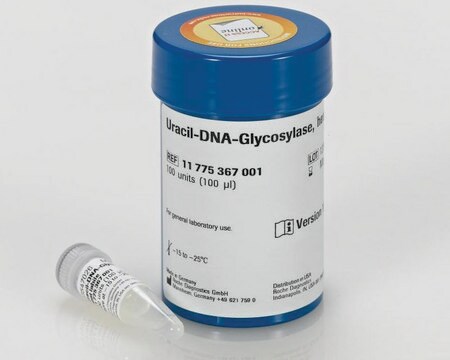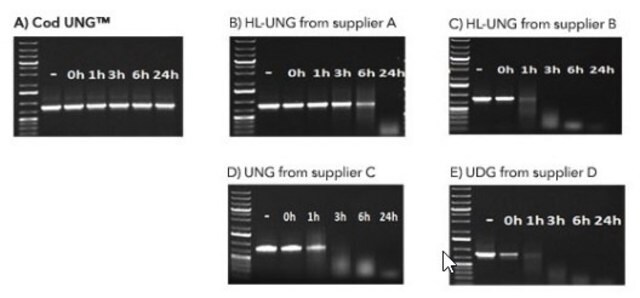11444646001
Roche
Uracil-DNA Glycosylase
recombinant from E. coli K 12
Synonym(s):
PCR, UDG
About This Item
Recommended Products
recombinant
expressed in E. coli
Quality Level
form
solution
packaging
pkg of 100 U
manufacturer/tradename
Roche
concentration
1000 U/mL
technique(s)
PCR: suitable
mutagenesis: suitable
color
colorless
pH
7.9-8.1 (68 °F)
solubility
water: miscible
suitability
suitable for molecular biology
application(s)
life science and biopharma
foreign activity
RNases 10 units, none detected
endonuclease 20 units, none detected
storage temp.
−20°C
Related Categories
General description
Specificity
- Uracil-DNA glycosylase hydrolyzes uracil-glycosidic bonds at U-DNA sites in single- and doublestranded DNA, excising uracil and creating alkali sensitive abasic sites in the DNA.
- The enzyme is more active on single-stranded DNA than on double-standed DNA.
- Activity was also observed on small U-DNA oligonucleotides and on dUMP (Duncan, unpublished observations).
- Uracil-DNA glycosylase is inactive on RNA and native, uracil-free DNA.
Heat inactivation: 95 °C for 10 min
Uracil-DNA glycosylase remains partially active (<10%) after an incubation period of 30 minutes at 95 °C.
Application
- Prevent carryover contamination in PCR
- Increase the efficiency of site-directed mutagenesis procedures
- Label oligonucleotide probes
Quality
Unit Definition
One Lindahl unit is defined as the amount of enzyme necessary to release of 1 μmol uracil at +37 °C in 1 minute. One Lindahl unit is comparable to 520,000 U based on our unit definition.
Volume Activity: 1 U/μl
Physical form
Storage and Stability
Other Notes
Storage Class Code
12 - Non Combustible Liquids
WGK
WGK 1
Flash Point(F)
No data available
Flash Point(C)
No data available
Certificates of Analysis (COA)
Search for Certificates of Analysis (COA) by entering the products Lot/Batch Number. Lot and Batch Numbers can be found on a product’s label following the words ‘Lot’ or ‘Batch’.
Already Own This Product?
Find documentation for the products that you have recently purchased in the Document Library.
Articles
DNA damage and repair mechanism is vital for maintaining DNA integrity. Damage to cellular DNA is involved in mutagenesis, the development of cancer among others.
Our team of scientists has experience in all areas of research including Life Science, Material Science, Chemical Synthesis, Chromatography, Analytical and many others.
Contact Technical Service






